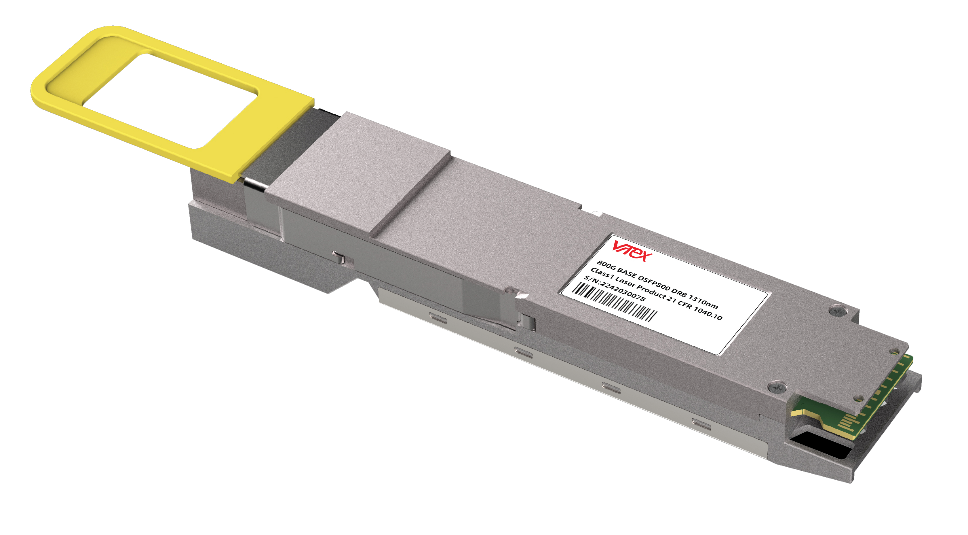
In the vast world of fiber optic technology, transceivers play a pivotal role in ensuring seamless data transmission over long distances. But, have you ever found yourself unsure of what a transceiver does, or what the name of the component means? We’ve been there, and we’re here to demystify the naming conventions of transceivers and shed some light on their significance.
Transceivers serve as the bridge between electrical and optical signals, facilitating the transmission of data across fiber optic networks. By converting electrical signals into optical ones, these devises enable data to travel extended distances with minimal data loss or interference. Some devices are even specified for low-latency. This offers cost-effective solutions compared to traditional copper cables.
So, what’s in a name? Transceiver are named by a few key factors: reach, data specifications, and data lanes. Let’s delve into the intricacies of these naming conventions:
Short Distance Transceivers:

For shorter distances, these crucial fiber optic devices are categorized into the SR (Short Range) and DR (Data Rate) series. The SR series accommodates distances of up to 100 meters, while the DR series extends up to 500 meters. These fiber optic components can utilize either single-mode fiber (SMF) or multimode fiber (MMF), operating at distinct wavelengths for optimal performance. You can read more about the differences between SMF and MMF here.
- SR Series: Utilizing multimode fiber, the SR series is denoted by a number indicating the number of fiber pairs per direction. For instance, SR8 signifies 8 fiber pairs (8 transmit and 8 receive), facilitating robust data transmission over short distances.
- DR Series: Utilizing either SMF or MMF, the DR transceivers also support multiple fiber pairs, with DR4 featuring 4 pairs for enhanced connectivity.
| Transceiver Name | Meaning and Example |
|---|---|
| SR – Short Range | Up to 100m distance, i.e. 200G SR8 Breakout AOC |
| DR – Data Rate | Up to 500m distance, i.e. 400G QSFP DR4 Transceiver |
| SMF – Single-Mode Fiber | Operates in 1200-1600 nanometer wavelength range, i.e. Single Mode 12-fiber MPO |
| MMF – Multimode Fiber | Operates in 850 nanometer wavelength, i.e. Multimode 16-fiber MPO |
Medium and Long Distance Transceiver:

For longer distances, transceivers fall into categories such as FR (Far Range, maximum distance of 2km), LR (Long Range, maximum distance of 10km), ER (Extended Range, maximum distance of 40km), and ZR (can reach 80km distances and above). Each series boasts varying reach capabilities, catering to diverse network requirements.
- FR, LR, ER, ZR Series: Each offers extended reach capabilities, with ER and ZR variants providing even greater distances. ER4 utilizes wavelength division multiplexing (WDM) technology, splitting data into four optical lanes per direction.
| Transceiver Name | Meaning and Example |
|---|---|
| FR – Far Range | Up to 2km reach distance, i.e. 800G QSFP FR4 |
| LR – Long Range | Up to 10km reach distance, i.e. 200G QSFP LR8 |
| ER – Extended Range | Up to 40km reach distance, i.e. 100G QSFP28 ER4 |
| ZR – Zero Dispersion | Can reach 80km distances and above, i.e. 10G SFP+ZR DWDM |
| WDM – Wavelength Division Multiplexing | 4-way data transmission split between optical lanes, i.e. 40G QSFP+ ER4 |
Understanding the nuances of transceiver naming is crucial for selecting the right components to meet your networking needs. Whether you’re establishing a local network or spanning vast distances, choosing the appropriate device ensures optimal performance and reliability.
In summary, transceiver names serve as a roadmap to navigating the complex landscape of fiber optic connectivity. By deciphering these conventions, you empower yourself to make informed decisions when selecting transceivers for your network infrastructure. So, the next time you encounter a device name like 200G SR8 or 100G LR4, rest assured that you’re equipped with the knowledge to understand its capabilities and compatibility with your network setup.
For more insights and posts like this, subscribe to our newsletter and never miss an update. Follow Vitex on Linkedin to stay up to date on all things fiber optics, and if you have any specific needs or questions, feel free to email info@vitextech.com

